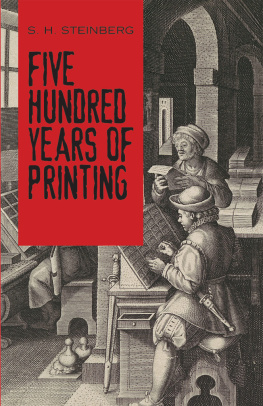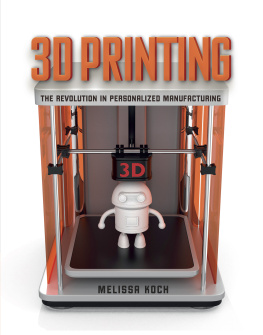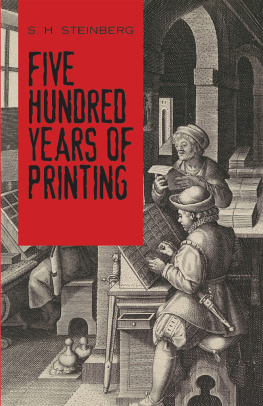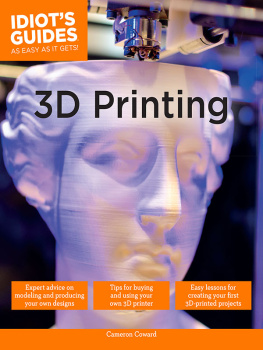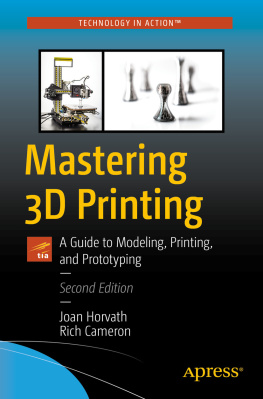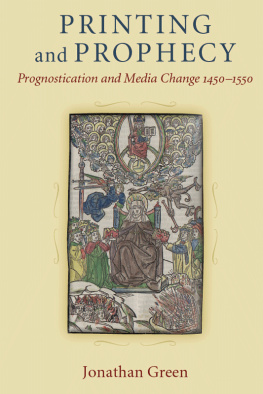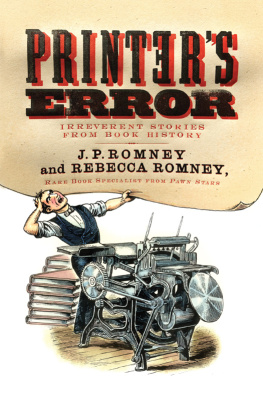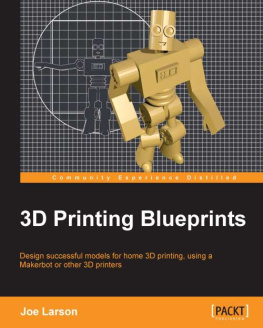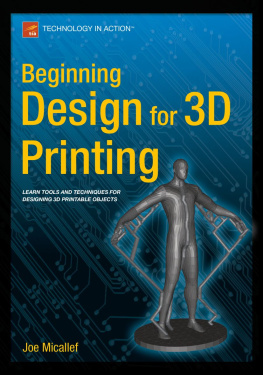FIVE
HUNDRED
YEARS OF
PRINTING
S.H. STEINBERG
S. H. STEINBERG
FIVE
HUNDRED
YEARS OF
PRINTING
WITH A FOREWORD
BY BEATRICE WARDE
DOVER PUBLICATIONS, INC.
MINEOLA, NEW YORK
Bibliographical Note
This Dover edition, first published in 2017, is an unabridged republication
of the work originally published by Penguin Books Ltd., Baltimore,
Maryland, in 1955.
International Standard Book Number
ISBN-13: 978-0-486-81445-2
ISBN-10: 0-486-81445-9
Manufactured in the United States by LSC Communications
81445901 2017
www.doverpublications.com
Contents
Foreword
T HESE were the five hundred years of the Printer. These were the centuries in which there was his way, but no other way, of broadcasting identical messages to a thousand or more people, a thousand or more miles apart. This was the epoch that we have been calling modern times.
We gave it that name because we have imagined ourselves as standing on this side of the deep cleft-in-history that opened up midway of the fifteenth century: the cleft into which Johann Gutenberg and his followers drove those leaden wedges that are called printing types, and split us clean away from that almost inconceivable world in which there was no such thing as printing.
But what if another such cleft proves to have been opening just behind us, in this very century? It is not easy for our children now to imagine a world in which there were no loudspeakers. Already the demagogues have almost forgotten how handicapped they were in that day-before-yesterday when there were no softspeakers: no radio-waves to carry a stage-whisper of scorn or passion into ten million susceptible ears at the same instant. The children, as they grow to maturity, will become increasingly familiar with such phrases as the year 2000, the Third Millennium. The mysterious power that is in round numbers will impel them to look with fresher, more far-sighted eyes upon those thousand years that will have passed in some night before they are sixty. They will be as convinced as we are that something ended and something else began with Gutenbergs invention. But I think that they will find other names for the epochs on either side of the cleft. Whatever they call the one on the farther side, it will no longer be the middle ages. Whether or not they name these past five centuries the Epoch of Gutenberg, they will at least come to look upon it as another middle section of human history: that in which only the graphic word the word that has to be wrested from conventional signs by the acquired power of literacy had yet attained the enormous strength of mechanical multiplication. They will scarcely be able to stretch the phrase modern times so far back, over a period that has suddenly become so different and remote from the one that began with Edison and Marconi.
Printing graphic communication by multiplied impressions will go on as long as civilization goes on. Its presses have trundled serenely across the new cleft in history. Necessity built the bridge. All that the printers have had to leave behind is their singularity as disseminators of ideas on a vast scale. But that is, on the whole, a beneficial loss. Who can perceive what a thing really is (and so judge its value), without first noticing what it most obviously and particularly is not? No wonder Kiplings famous question has been so often paraphrased. What do they know of [any thing], who only [that thing] know? It was by peering back into the age of the manual copyist that we came to realize that what Gutenberg gave us was first and foremost the means of correcting texts in advance, and then making sure that whatever errors crept past the proofreader could be located at a given point on a given page, in any one of a thousand copies struck off from the same forme of type. From that new possibility stemmed the concept of the edition, with all that it has meant to scholarship, to invention, and hence to our daily lives. That much we have been able to see all along. But the contrast between the scribe and the press only shows us that printing is the safer (and of course the speedier) way of getting messages into many peoples heads through their eyes. There remained the far more dramatic and fundamental contrast between the graphic and the oral word: between the emotional impact of the human voice and the cold, silent precision of the graphic message: between the exciting evanescence of the spoken word and the special, frightening power which the written one has of keeping on saying the thing long after any knave or liar would wish it to do so.
The contrast was there, but it told us less than we needed to know about the importance and virtue of printing, because it was too easy to discount the influence of even the most hypnotic human voice as long as it had to struggle to be audible to as few as a thousand listeners at one time. To-day we have a fairer comparison of means. It is revealing to us the glory and dignity of the three great privileges that the printed word allows to its recipients, which the spoken word cannot offer even now when it has the use of its own vast multiplication-process.
We have the privilege of turning back from the page on which we have found something debatable, in order to find and re-read that point where the argument started (as every argument must start) with an assumption. Was it perhaps a false assumption that we were being hurriedly begged to accept for the sake of argument? We can find out then and there, without having to lose the thread of what is to follow.
And we can turn forward to the end, or far enough ahead to see what conclusion the fellow is driving toward. If he is selling us anything, we can find out what he wants us to buy some time before he has come around to mentioning it.
And the third privilege is that of stopping short at any word or statement that seems to call for meditation, verification, or resort to the dictionary.
Printing is on the side of the people who still have the courage to say Stop, I want to think about that, or Surely that wasnt what you said before? or What are you getting at? It does take courage to say such things, even to the amenable printed page, let alone to the vocal spellbinder: and there is no way whatever of saying such things to the reproduced-voice that comes to us through the loudspeaker.
But the future of any form of democratic government depends on keeping that sort of courage alive.
*
In the year forty of each century there are celebrations of the Invention of Movable Type. The printers turn out handsome broadsheets and booklets in honour of the ars conservatrix artium, and Providence arranges the appropriate pageant. In 1840 it showed us how recent inventions the power-driven printing machine, the paper-making machine and others had at long last made possible the dream of universal literacy, hence the universal franchise. For the demi-millennial celebration it chose Fireworks, and ironically allowed a German to set them off to the deep and permanent embarrassment of the noble city of Mainz and the shade of Gutenberg. For those Fireworks began with book-bonfires, and blazed up into white explosions which very clearly lit up the new cleft in history.
To me as the editor of a paper concerned with typography it seemed a good moment to call upon Mr Steinberg for a summary of what had really happened as the result of the invention of type and the press. You are not likely to come across the number of the Monotype Recorder which contains the 12,000-word gist and promise of this present book. What with the paper famine and the bombs, few copies survive. But those that do have been worn shabby in passing from hand to hand. In this book you have the fuller story. Here are the five hundred years of Printing as a creator of changes in human lives. It will continue to bring changes into our lives; but its greatest task will be to help keep something intact which we were a long time earning something too precious to be stolen from us by the hypnotic chanting of slogans.
Next page
